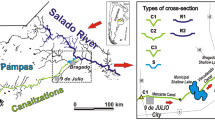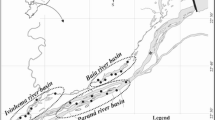Abstract
We examined the quantitative and qualitative zooplankton community structure in two small rivers flowing out from lakes differing in trophic conditions. Within each river, three sites were chosen for the collection of drifted zooplankton: one at the outflow, and two at distances of 0.2 km and 1 km from the outflow. The most significant difference in zooplankton community between the outflow and the lower course of the river occurred in the first section directly after the outflow. These differences in the zooplankton community were driven largely by crustaceans, which declined faster in the river flowing out from the mesotrophic lake. Physical parameters mainly impacted the zooplankton community found in the river flowing from the mesotrophic lake; however, chemical parameters also had an impact in the river discharging from the strongly eutrophic lake.
Similar content being viewed by others
References
Ejsmont-Karabin J., Węgleńska T., Changes in the zooplankton structure in the transitory river — lake — river zone. The River Krutynia system, Mazurian Lake District, Zesz. Nauk. Kom. „Człowiek i Środowisko”, 1996, 13, 263–289, (in Polish)
Akopian M., Garnier J., Pourriot R., A large reservoir as a source of zooplankton for the river: structure of the populations and influence of fish predation, J. Plankton Res., 1999, 21, 285–297
Pithart D., Pichlová R., Bílý M., Hrbáček J., Novotná P., Pechar L., Spatial and temporal diversity of small shallow waters in river Lužnice floodplain, Hydrobiologia, 2007, 584, 265–275
Lair N., A review of regulation mechanisms of metazoan plankton in riverine ecosystems: aquatic habitat versus biota, River Res. Appl., 2006, 22, 567–593
Illyová M., Bukvayová K., Némethová D., Zooplankton in a Danube River Arm near Rusovce (Slovakia), Biologia, 2008, 63, 566–573
Lazareva V.I., Distribution and Special Traits of Naturalization of New and Rare Zooplankton Species in Waterbodies of the Upper Volga Basin, Inland Wat. Biol., 2008, 1, 76–83
Bothar A., Kiss K.T., Phytoplankton and zooplankton (Cladocera, Copepoda) relationship in the eutrophicated River Danube, Hydrobiologia, 1990, 191, 165–171
Walks D.J., Cyr M., Movement of plankton through lake-stream systems, Freshw. Biol., 2004, 49, 745–759
Chang K.H., Doi H., Imai H., Gunji F., Nakano S.I., Longitudinal changes in zooplankton distribution below a reservoir outfall with reference to river planktivory, Limnology, 2008, 9, 125–133
Karabin A., Pelagic zooplankton (Rotatoria + Crustacea) variation in the process of Lake Eutrophication. I. Structural and quantitative features, Ekol. Pol., 1985, 33, 567–616
Dodson S.I., Newman A.L., Will-Wolf S., Alexander M.L., Woodford M.P., Van Egeren S., The relationship between zooplankton community structure and lake characteristics in temperate lakes (Northern Wisconsin, USA), J. Plankton Res., 2009, 31, 93–100
Estlander S., Nurminen L., Olin M., Vinni M., Horppila J., Seasonal fluctuations in macrophyte cover and water transparency of four brown-water lakes: implications for crustacean zooplankton in littoral and pelagic habitats, Hydrobiologia, 2009, 620, 109–120
Davidson N.L. Jr., Kelso W.E., Rutherford A.D., Characteristics of cladoceran and copepod communities in floodplain habitats of the Atchafalaya River Basin, Hydrobiologia, 2000, 435, 99–107
Czerniawski R., The effect of flow-through reservoirs on zooplankton of the Płonia river, Pol. J. Nat. Sci., 2008, 23, 583–597
Ejsmont-Karabin J., Kruk M., Effects of contrasting land use on free-swimming rotifer communities of streams in Masurian Lake District, Poland, Hydrobiologia, 1998, 387/388, 241–249
Wagler E., Klasse: Crustacea, Krebstiere. Die Tierwelt Mitteleuropas II, 2a, Leipzig, 1937, (in German)
Kutikova L.A., Kolovratki fauny SSSR (Rotatoria). Podklass Eurotatoria (otryady Ploimida, Monimotrochida, Paedotrochida), Nauka, Leningrad, 1970, (in Russian)
Harding J.P., Smith W.A., A key to the British freshwater cyclopid and calanoid copepods, FBA Special Publication, Far Sawrey, Cumbria, Freshwater Biological Association, 1974
Rybak J.I., A review of freshwater invertebrates, part. V, benthic Invertebrates, PIOŚ. Bibl. Monit. Środ, 1996, Warszawa, (in Polish)
Rybak J.I., Freshwater Invertebrates, PWN, 2000, Warszawa, (in Polish)
Ejsmont-Karabin J., Empirical equations for biomass calculation of planktonic rotifers, Pol. Arch. Hydrobiol., 1998, 45,4, 523–522
Ruttner-Kolisko A., Suggestion for biomass calculation of plankton rotifers, Arch. Hydrobiol. Beih. Ergebn. Limnol., 1977, 8, 71–76
McCauley E., The estimation of the abundance and biomass of zooplankton in samples, In: Downing J.A., Rigler F.H., (Eds.), A manual on methods for the assessment of secondary productivity in fresh waters, IBP Hand Book 17, Blackwell Science Ltd., Oxford, UK, 1984, 228–265
Carlson R.E., A trophic state index for lakes, Limnol. Oceanogr., 1977, 22, 361–369
Shannon C.E., Weaver W., The mathematical theory of communication, University of Illinois Press, Urbana, 1949
Oksanen J., Kindt R., Legendre P., O’Hara B., Simpson G.L., Solymos P., et al., The Vegan Package, 2008, 1, 15–1, available via http://cran.r-project.org/web/packages/vegan/vegan.pdf
Armitage P.D., Capper M.H., The numbers, biomass and transport downstream of micro-crustaceans and Hydra from Cow Green Reservoir (Upper Teesdale), Freshw. Biol., 1976, 6, 425–432
Szlauer B., The zooplankton removal from lakes by the River Płonia, Acta Icht. Piscat., 1977, 2, 39–53
Sandlund O.T., The drift of zooplankton and microzoobenthos in the river Strandaelva, western Norway, Hydrobiologia, 1982, 94, 33–48
Szlauer L., Using the zooplankton removed from lakes for fry feeding of Coregonus lavaretus (Linnaeus, 1758), Rocz. Nauk Rol., 1974, 96, 89–107, (in Polish)
Basu B.K., Pick F.R., Factors regulating phytoplankton and zooplankton biomass in temperate rivers, Limnol. Oceanogr., 1996, 41, 1572–1577
Lauridsen T.L., Pedersen L.J., Jeppesen E., Søndergaard M., The importance of macrophyte bed size for cladoceran composition and horizontal migration in a shallow lake, J. Plankton Res., 1996, 18, 2283–2294
Cerbin S., Donk E., Gulati R.D., The influence of Myriophyllum verticillatum and artificial plants on some life history parameters of Daphnia magna, Aquat. Ecol., 2007, 41, 263–271
Kornijów R., Vakkilainen K., Horppila J., Luokkanejn E., Kairesalo T., Impacts of a submerged plant (Elodea canadensis) on interactions between roach (Rutilus rutilus) and its invertebrate communities in a lake littoral zone, Freshw. Biol., 2005, 50, 262–276
Kuczyńska-Kippen N., Nagengast B., The influence of the spatial structure of hydromacrophytes and differentiating habitat on the structure of rotifer and cladoceran communities, Hydrobiologia, 2006, 559, 203–212
Gliwicz Z.M., Predation or food limitation: an ultimate reason for extinction of planktonic cladoceran species, Erg. Limnol., 1985, 21, 419–430
O’Brien W.J., Planktivory by freshwater fish: thrust and parry in the pelagia, In: Kerfoot W.C., Sih A., (Eds.), Predation. Direct and Indirect Impacts on Aquatic Communities, University Press of New England, Hanover and London, 1987, 3–16
Radwan S., Popiolek B., Percentage of rotifers in spring zooplankton in lakes of different trophy, Hydrobiologia, 1989, 186/187, 235–238
Mäemets A., Rotifers as indicators of lake types in Estonia, Hydrobiologia, 1983, 104, 357–361
Hillbricht-Ilkowska A., Shallow lakes in lowland river systems: Role in transport and transformations of nutrients and in biological diversity, Hydrobiologia, 1999, 408/409, 349–358
Minshall G.W., Cummins K.W., Petersen R., Cushing C.E., Bruns D.A., Sedell J.R., et al., Development in stream ecosystem theory, Can. J. Fish. Aquat. Sci., 1985, 42, 1045–1052
Cummins K.W., Cushing C.E., Minshall G.W., An overview of stream ecosystems, In: Cushing C.E., Cummins K.W., Minshall G.W., (Eds.), Rivers and Stream Ecosystems. Ecosystems of the World, Elsevier, Amsterdam, 1995, 22, 1–8
Wissel B., Boeing W.J., Ramcharan C.W., Effects of water color on predation regimes and zooplankton assemblages in freshwater lakes, Limnol. Oceanogr., 2003, 48, 1965–1976
Sousa W., Luiz Attayde J.D.A., Silva Rocha E., Eskinazi-Sant’Anna E.M., The response of zooplankton assemblages to variations in the water quality of four man-made lakes in semi-arid northeastern Brazil, J. Plankton Res., 2008, 30, 699–08
Żurek R., Response of rotifers to hydrochemical and biotic factors, Oceanol. Hydrobiol. St., 2006, 2, 121–139
Pace M.L., Findlay S.E.G., Lints D., Zooplankton in advective environments: the Hudson River community and a comparative analysis, Can. J. Fish. Aquat. Sci., 1992, 49, 1060–1069
Ejsmont-Karabin J., Ammonia nitrogen and inorganic phosphorus excretion by the planktonic rotifers, Hydrobiologia, 1983, 104, 231–236
Campbell C.E., Rainfall events and downstream drift of microcrustacean zooplankton in a Newfoundland boreal stream, Can. J. Zool., 2002, 80, 997–1003
Nielsen D., Watson G., Petrie R., Microfauna communities in three lowland rivers under differing flow regimes, Hydrobiologia, 2005, 543, 101–111
Author information
Authors and Affiliations
Corresponding author
About this article
Cite this article
Czerniawski, R., Domagała, J. Zooplankton communities of two lake outlets in relation to abiotic factors. cent.eur.j.biol. 5, 240–255 (2010). https://doi.org/10.2478/s11535-009-0062-9
Received:
Accepted:
Published:
Issue Date:
DOI: https://doi.org/10.2478/s11535-009-0062-9




